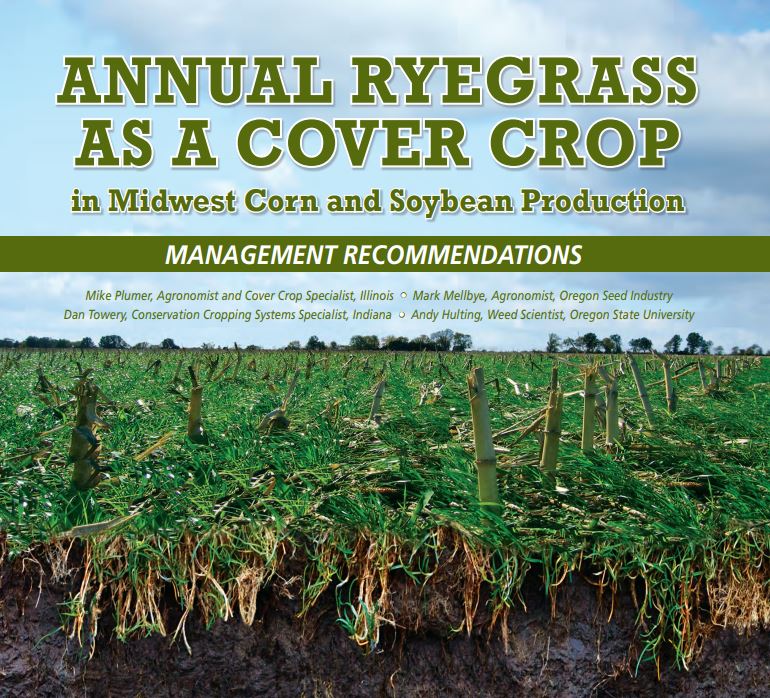One Helping Hand Deserves Another
Jamie Scott, a 3rd generation Indiana farmer now in his mid-40s, grew up having heard about no-till and cover crops from his dad and grandad. As you may have read in earlier posts, no-till was barely on Midwest farmers’ radar screen in the 1980s, and cover cropping was even more of a rarity.
The Scotts had not adopted the practice vigorously at that time, and conventional tillage still ruled the day on their farm and most others farms as well. Nonetheless, the Scotts were not averse to it, which made a big difference. “My granddad would hand-sow clover or plant cereal rye with a spreader after harvest on certain plots,” Jamie said. “And I remember my dad telling me about his buying the farm next door in 1976. The previous owner, like my grandad, had also used cover crops. My dad was amazed to learn the difference between that neighbor’s fields and some of ours. Where he had consistently used cover crops, the organic matter was at or just above 4.0, compared to tilled acreage like ours which in places was as low as 2.5. That got my dad’s attention!”
It wasn’t until after attending a couple of ag conferences in 2002, though, that Jamie and his dad began to get serious with no-till and cover crops on their 2000 acres northwest of Fort Wayne. He visited the Oregon Ryegrass booth at the National No-Till Conference that year, and the Farm Machinery Show in Louisville, talking with Oregon grass seed growers Larry Venell and Don Wirth. “They were skeptical that I would be able get annual ryegrass to winter over that far north,” Jamie chuckled. “Back then, they thought annual ryegrass wouldn’t stand up to winter weather much north of I-70,” he added, “and we’re 125 miles north of there! One of the things that was helpful at the time was that they didn’t try to cover up what they didn’t know about ryegrass as a cover crop and how to manage it in this environment.”

Jamie Scott, Indiana farmer and cover crop advisor – https://www.no-tillfarmer.com/articles/7463-no-tiller-discusses-rotation-and-cover-crop-strategies
Fast forward to 2021. The entire Scott farm acreage is in no-till and cover crops. Jamie has become a regional expert on cover crops and oversees application and management of cover crop seed on more than 100,000 acres a year in his area. “If it weren’t for the Oregon Commission, and guys like Mike Plumer and Dan Towery to help me out, I probably wouldn’t be working with cover crops at all,” he said. “Their knowledge and willingness to come out to work through it with me was crucial.”
Their first year, after the corn and beans had come off the fields, Jamie and his dad Jim put in about 40 acres of annual ryegrass. “In that first year, the seed had three varieties in the same bag,” he said, “and this was before they had figured out which varieties were the hardiest. So, our results were mixed,” he added. “One corn field looked great, another was so-so, and the bean field we planted too late with annual ryegrass looked like nothing happened at all. But, the next spring, it turned out that even in the bean field, the ryegrass had sent out a lot of roots and we got benefits without much top growth. And in each of those fields, production was improved over fields where no cover crops were planted. We were sold after that,” he said. “In fact, I was driving by the bean field with an agronomist the following year, and he noticed without my saying anything that the beans where annual ryegrass had been planted looked greener and healthier.”
“I’ve come to understand that as stresses increase, like droughts, the greater are the benefits of cover crops,” Jamie added. “Take for example the deep rooting of annual ryegrass. It creates root channels that are used by corn plants to access moisture far deeper than otherwise. In dry years the difference in yield between cover-cropped acres and those in conventional tillage is remarkable.”
“The knowledge we lost in the 20th Century about
no-till and cover crops is coming back,” Jamie continued. “After generations of
nothing but deeper and deeper tillage, we’re becoming more conservation-minded
as an industry. We’ve come to appreciate the connection between cover crops,
soil health and crop production. On our property, we’ve gradually built the
organic matter back up, and it has more than paid for itself in healthier soil
and better production.




